#document workflow management software
Explore tagged Tumblr posts
Text
The Real Reason Smart Teams Are Switching to Workflow Automation Software
Let’s cut to the chase: if you’re still emailing files around, waiting on approvals that go MIA, and wondering where the latest version of a doc is even if… you’re spending way too much time on stuff that should already be done.
It’s not your fault—it’s the system. Or more accurately, the lack of one.
But there’s good news: document workflow automation exists, and it’s not just for big companies anymore. It’s for regular teams, doing regular work, who are just tired of the chaos.

Real Talk: Manual Processes Are Slowing You Down
We all do it. A file gets created, then emailed, then edited, then… someone forgets to respond. So you follow up. Then they send back a version with “FINAL_FINAL” in the name, but wait—there’s another version that someone else updated?
You’re stuck in document limbo.
That’s why workflow automation software is such a game-changer. You set it up once, and from then on, your docs move where they need to go. Automatically. No chasing. No checking in. No “Did you get a chance to look at that yet?”
Why SaaS-Based Workflow Tools Are the Unsung Heroes
You don’t need a fancy server room or a tech team to use automation tools anymore. That’s the beauty of SaaS workflow software—you just log in, and everything’s there. It works from your browser, your phone, your couch—wherever you’re working.
It updates itself, it’s secure, and it scales as your team grows. Whether you’re three people or thirty, it fits.
And best of all? No IT headaches. (Let’s be honest—that’s a big win.)
File Sharing Alone? Not Enough Anymore.
Uploading a doc to Google Drive or Dropbox is fine, but what happens next? Who’s responsible for reviewing it? Approving it? Sending it on?
That’s where a document sharing platform with real workflow features steps in. It doesn’t just store your files—it moves them through your process.
Need someone to sign something? It’ll remind them. Need an update before Friday? It’ll ping the right person. You don’t have to play traffic cop anymore.
Smart Document Management = Less Mess, More Focus
How much time have you lost looking for that one file from last quarter? You know it’s somewhere... but where?
Cloud document management solutions make that a thing of the past. They help you organize everything neatly, find what you need instantly, and make sure the right people have access—without digging through folder spaghetti.
And when you pair that with workflow automation tools, the magic really happens. Upload a file, and boom—it’s routed to legal, then to finance, then back to you. No reminders. No confusion. No stress.
Picking the Right Tool Doesn’t Have to Be a Project
There are a lot of options out there, and it’s easy to get overwhelmed. But at the end of the day, the best workflow management software is the one that:
You and your team actually like using
Makes your work faster, not harder
Connects with tools you already have (email, Slack, Google Drive, etc.)
Keeps your documents secure and backed up
That’s it. Don’t overthink it.
You Deserve Easier Workdays
You’re busy. Your team is busy. Nobody has time to babysit documents.
So why are you still doing it?
With document workflow automation, cloud document management, and the right SaaS workflow software, you can stop wasting time on things that should already be automatic.
Let the system handle the busywork—so you can focus on the stuff that actually matters.
Seriously. You’ve got better things to do.
#document workflow automation#saas workflow software#document sharing platform#workflow automation tools#cloud document management solutions#workflow automation software#workflow management software
0 notes
Text
Why E-Commerce Applications Are the Future of Retail
Why E-Commerce Applications Are the Future of Retail
E-commerce has reshaped modern retail by transforming how consumers shop and how businesses sell. What began as a niche option is now a dominant global trend. Today, e-commerce applications are the backbone of online retail, helping businesses scale, increase visibility, and serve customers 24/7.
The Rise of E-Commerce Applications
Thanks to smartphones, high-speed internet, and cloud computing, shopping is easier, faster, and more mobile than ever. Mobile shopping apps now offer end-to-end functionality — from product discovery to customer service — all within a user-friendly interface. Businesses in every industry are investing in e-commerce app development to future-proof their sales strategy.
Core Benefits of Using E-Commerce Applications
🌐 Global Reach
Break free from physical limitations. With online store applications, businesses can reach global customers, increasing their market share and visibility without setting up physical branches.
🕒 24/7 Shopping Convenience
Your store is open around the clock. Mobile e-commerce apps allow users to shop anytime, anywhere — making retail more accessible and customer-focused.
🎯 Personalized Experience
Data analytics allows personalized shopping apps to suggest products, promotions, and updates tailored to each user’s preferences and behavior.
💳 Seamless Payments
From credit cards to digital wallets and even cryptocurrency, secure and flexible payment gateways make checkout effortless. An integrated e-commerce payment system builds trust and improves conversions.
📱 Mobile-First Access
With a growing mobile audience, mobile commerce platforms are essential. A well-optimized app ensures smooth shopping experiences across all devices.
Key Features of a Great E-Commerce App
To succeed, your custom e-commerce application must include features that drive engagement, trust, and retention.
Intuitive Interface: User-friendly layout with fast loading and clean design
Smart Search: Quick filters, voice search, and product tags for fast discovery
Reviews & Ratings: Builds transparency and credibility
Fast Checkout: One-click checkout, multiple payment modes, and address auto-fill
Order Tracking: Real-time updates from order confirmation to delivery
Built-in Support: AI-powered chatbots or live chat for seamless support
Why Invest in E-Commerce App Development?
🚀 Stay Competitive
A well-designed retail app enhances user experience and makes your brand stand out in a crowded digital space.
💰 Boost Revenue
E-commerce mobile app development leads to higher conversion rates, upselling opportunities, and long-term customer retention.
🔔 Engage Customers
Use push notifications, loyalty program integration, and promo alerts to stay top-of-mind.
📈 Scale with Ease
Add products, manage multiple locations, or integrate with logistics — all within a scalable e-commerce platform.
The Future of E-Commerce
Looking ahead, AI-driven e-commerce apps, AR shopping apps, and voice-based retail apps will define the next wave of innovation. With a focus on sustainability and personalization, green e-commerce solutions will also appeal to ethical shoppers.
Final Takeaway
E-commerce applications are no longer optional — they’re a necessity for businesses seeking long-term success. By investing in robust e-commerce app development, you empower your brand to deliver seamless, secure, and scalable shopping experiences. Whether you're a startup or an enterprise, a future-ready online store app ensures your business thrives in the digital age.
#custom ecommerce solutions in Fujairah#ecommerce software in Ras Al Khaimah#online business app in Umm Al Quwain#best ecommerce app developers in UAE#CRM software providers in UAE#sales automation CRM in Fujairah#cloud CRM system in Dubai#document management system software#affordable custom software development in UAE#workflow solution in UAE#paperless office in UAE
0 notes
Text
Social Media Marketing: Why is it so Important?
What Is Social Media Marketing?
Social Media Marketing is the use of social media to build a brand, increase sales, and drive traffic to a website. Social media are the platforms on which users build social networks and share information. Furthermore, social media marketing (SMM) provides marketers with a way to track the success of their efforts and identify even more ways to engage with existing customers and reach new ones.
Why Is Social Media Marketing So Powerful?
In three core marketing areas: connection, interaction, and customer data, social media marketing (SMM) is far more powerful than any other marketing strategy.
Connection: Social media not only allows businesses to connect with their customers in ways previously impossible, but it also provides an extraordinary range of channels for connecting with the target audience—from video platforms (like YouTube) to social networking sites (like Facebook) to microblogging services (like Twitter).
Interaction: Through social media interactions-whether direct communication or passive businesses can leverage free advertising opportunities from electronic word-of-mouth recommendations between existing and potential customers. The positive contagion effect of eWOM is not only an important driver of consumer behavior, but the fact that these interactions occur on social networks makes them measurable as well. Using social media marketing (SMM) campaigns, businesses can measure their “social equity”-a term for return on investment (ROI).
Customer Data:
Boosting marketing outcomes with social media marketing (SMM) relies on another key resource: customer data. Rather than being overwhelmed by big data’s 3Vs (volume, variety, and velocity), SMM tools utilize customer data and turn it into actionable market analysis-or even crowdsource new strategies based on that data.
How Social Media Marketing Works?
The rise of social media platforms like Facebook, Twitter, and Instagram transformed not only how we connect with each other, but also how businesses can influence consumer behavior—from creating engaging content to extracting demographic, geographic, and personal information that helps messaging resonate.
SMM Action Plan:
It is more effective to target your social media marketing (SMM) strategy. The following action plan is recommended by Hootsuite, a leading provider of social media management software:
Ensure SMM goals are aligned with business objectives.
Get to know your target customer (age, location, income, job title, industry, interests).
Examine your competition’s successes and failures (competitive analysis).
Review your current SMM (failures and successes).
Create a calendar for SMM content delivery.
Create best-in-class content.
Track performance and adjust SMM strategy as needed.
#Digital marketing#Digital Transformation#Digital document solutions#Workflow management software#Document security solution#virtualwebs#web development company in goa#Seo Experts in goa#Search Engine Optimization agency in goa#Video Marketing agency in goa#website design and development company in goa#web designers in goa
0 notes
Text
Enhancing Audit Workflow Management with Cutting-Edge Tools from AudTech
Introduction
In the ever-evolving landscape of finance, audit and accounting firms must adopt innovative workflow management tools to stay competitive and deliver high-quality services. This blog explores the latest trends in audit workflow management and how AudTech’s advanced software is setting new standards in the industry. https://audtech.co.in/2025/04/03/regulatory-updates-in-statutory-audits-key-compliance-changes-firms-need-to-be-aware-of/
AI and Machine Learning: The Future of Audit Efficiency
Artificial Intelligence (AI) and Machine Learning (ML) are revolutionizing audit workflows. By automating repetitive tasks, such as data collection and analysis, AI-driven tools help auditors focus on high-risk activities. AudTech’s software integrates AI to enhance data accuracy, identify anomalies, and provide predictive insights, streamlining the entire audit process.
Cloud-Based Solutions for Seamless Collaboration
Cloud computing is transforming audit workflow management by enabling real-time collaboration and accessibility. AudTech’s cloud-based platform allows auditors to access documents, share updates, and collaborate with clients from anywhere, at any time. This flexibility not only improves efficiency but also ensures that audit teams can work cohesively, even remotely.
Enhanced Data Security with Advanced Technologies
Data security is paramount in the auditing process. With increasing cyber threats, adopting robust security measures is essential. AudTech’s software incorporates state-of-the-art encryption and access control mechanisms, ensuring that sensitive financial data is protected against unauthorized access and breaches.
Real-Time Analytics and Reporting
Real-time analytics is a game-changer for auditors, providing immediate insights into financial data. AudTech’s platform offers advanced analytics tools that help auditors generate comprehensive reports quickly and accurately. This capability is crucial for making informed decisions and delivering timely audit results to clients.
Workflow Automation and Efficiency
Automated workflow management tools, such as those offered by AudTech, significantly enhance audit efficiency. These tools automate key audit processes, from planning and execution to reporting and follow-up. By reducing manual tasks, auditors can save time and focus on critical areas that require professional judgment.
Integration with Existing Systems
Modern audit workflow tools must integrate seamlessly with existing systems to maximize efficiency. AudTech’s software is designed to integrate with various financial and enterprise systems, ensuring a smooth workflow and eliminating data silos. This integration enhances data consistency and reduces the risk of errors.
Conclusion
Staying ahead in the competitive audit industry requires adopting the latest workflow management tools. AudTech’s advanced software provides auditors with the tools they need to enhance efficiency, accuracy, and client satisfaction. By leveraging AI, cloud computing, and automation, audit firms can streamline their workflows and deliver superior services in today’s digital age.
Contact
Office No. 810, 8th Floor,
LMS Finswell, Viman Nagar, Pune, Maharashtra, India, 411014
+91 9112118221 / [email protected]

0 notes
Text
Streamlining Operations with Document Automation Software for Small Business: PDQ Docs
For small businesses, managing paperwork and documentation can often become a cumbersome task, consuming valuable time and resources. From contracts and invoices to employee forms and legal documents, small business owners have to handle an array of documents daily. However, document automation software for small business, like PDQ Docs, offers an efficient and reliable solution to streamline these processes, saving time, reducing errors, and allowing business owners to focus on growth and innovation.
What is Document Automation Software?
Document automation software is designed to automate the process of creating, managing, and processing business documents. This type of software helps businesses generate professional, error-free documents quickly by using predefined templates, reducing the need for manual entry. Whether it's creating contracts, generating invoices, or filling out forms, document automation simplifies the workflow by integrating standard data and reducing human error.
Adopting document automation software for small business can lead to improved productivity and organization. Instead of spending countless hours manually drafting documents, businesses can rely on automation tools like PDQ Docs to ensure that all documents are generated quickly and accurately.

Why Small Businesses Need Document Automation Software
Small businesses often have limited resources, and inefficient document management can slow down operations, leading to missed opportunities and decreased profitability. By investing in document automation software, businesses can eliminate time-consuming manual tasks, cut down on operational costs, and maintain consistency across all their documents.
One of the key benefits of document automation software for small business is the reduction in human error. When creating documents manually, it's easy to overlook details or make mistakes, which can lead to costly errors or even legal issues. With automation, data is pulled directly from integrated sources, ensuring accuracy every time.
Moreover, automation increases the speed and efficiency of document-related tasks. Instead of creating documents from scratch, employees can use templates that automatically populate with the correct information, allowing for rapid document generation and faster decision-making. This enables small businesses to scale faster and operate more efficiently.
Why PDQ Docs is Perfect for Small Businesses
Small businesses often struggle with finding software that meets both their budgetary constraints and operational needs. PDQ Docs offers an affordable, scalable solution for businesses of all sizes, helping them streamline operations and improve efficiency without breaking the bank. The software can grow with the business, providing flexibility as needs evolve.
Conclusion
In a world where efficiency and accuracy are critical to business success, document automation software for small business is no longer a luxury—it’s a necessity. PDQ Docs offers small businesses the tools they need to automate and streamline their document management processes, saving valuable time and resources. By reducing errors, improving speed, and increasing productivity, PDQ Docs helps small businesses focus on what matters most: growth and innovation. Embracing document automation can make all the difference in staying competitive in today’s fast-paced business environment.
#document automation software for small business#document management software#automated document generation#business document workflow automation#small business document automation#paperless office solutions#document automation tools#customizable document templates#compliance document automation#document workflow software#time-saving document solutions#small business productivity tools
0 notes
Text
Benefits of Implementing ERP Software for Engineering Firms

The engineering industry is one of the biggest industries in the world, and it plays an important role in growing the economy as well. The engineering sector is growing day by day and is highly competitive. Hence, efficiency, accuracy, and streamlined operations are crucial for success in this sector. Businesses face several challenges in this sector, like the complexities of a project, resource management, and deadline restrictions. ERP software for engineering firms is the best way to overcome all of these challenges as it integrates and automates business processes.
Here is the list of top benefits of utilizing ERP systems for the engineering industry:
1. Project Management:
The projects in engineering sectors have a detailed documentation process, different teams, and complicated workflows. ERP system for engineering firms help in various ways, like centralizing project data, enabling limitless collaboration, and getting real-time updates. Because of this software, every team member has all the updates, which in turn reduces miscommunication and delays in the project.
2. Resource Management:
For all engineering projects, it is essential to allocate all resources carefully, like equipment, materials, and labor. With the utilization of ERP software, the monitoring of resources can be performed easily. It helps in checking resource availability, optimizing usage, and forecasting requirements. This ultimately results in improving cost efficiency.
3. Quality Management:
Ensures engineering projects meet industry standards and regulations.
Quality Control: Offers tools for monitoring and managing the quality of materials, processes, and completed projects.
4. Data Management:
Using ERP software, engineering firms can make sure that they can get a unified database to eliminate data silos and ensure consistency through all departments. A centralized data management system is beneficial for decision-making as well it provides critical information when required.
5. Time and Budget Management:
When the whole system gets automated with ERP software, it reduces time and cost on repetitive tasks like data entry, procurement, and inventory management. The utilization of ERP systems in engineering firms helps in reducing manual errors and improving productivity. Hence, the firms can focus on other important things like innovation and project execution.
6. Client Relationship Management:
Most ERP systems include customer relationship management tools that are very helpful in managing client interactions. This tool allows the firm to track communication history, project milestones, and client preferences. Because of this feature, firms can improve customer satisfaction and build long-term relationships.
7. Scalability and Flexibility
ERP solutions may scale with the company as it grows, allowing for more projects, clients, and resources. Customization: ERP solutions can typically be tailored to an engineering firm’s specific demands and operations.
8. Financial Management
Accounting combines financial accounting with project management to provide a complete picture of the company’s financial health. Reporting: Creates detailed financial reports, such as profit and loss statements, balance sheets, and cash flow statements.
How PMTRACK ERP Helps:
Managing development processes, monitoring complex projects, and ensuring seamless collaboration across divisions are becoming increasingly important for company success. Engineering organizations in Pune, India, and around the world have distinct issues in successfully managing their operations.
Implementing a bespoke Enterprise Resource Planning (ERP) solution provides transformative benefits by streamlining processes, improving project management, and ultimately generating profitability.
For businesses considering ERP adoption, selecting the correct ERP software vendor is critical. PMTRACK ERP, a reputable ERP solution provider in Pune, India, specializes in engineering ERP systems tailored to the demands of engineering and manufacturing companies.
ERP software is used to connect project management with financial accounting, inventory control, and procurement procedures. This integration gives project managers real-time information about project costs, resource availability, and schedules, resulting in better-informed decisions and more effective project execution.
Engineering firms that use an ERP system can improve operational efficiency, reduce costs, improve project delivery, and ultimately boost client satisfaction and profitability.
Summary:
ERP software provides several advantages to engineering firms in Pune, India, ranging from better project management and financial control to higher client satisfaction and scalability. Engineering organizations can employ a comprehensive ERP solution to improve operations, decrease inefficiencies, and drive long-term growth.
PMTRACK ERP, one of the leading ERP solution providers in Pune, India, provides comprehensive, industry-specific ERP solutions that are suitable for engineering organizations’ unique requirements. Firms that collaborate with an experienced engineering ERP software company in India receive a trusted partner in negotiating the complexity of their business, setting them up for success in an increasingly competitive landscape.
#efficiency#accuracy#and streamlined operations are crucial for success in this sector. Businesses face several challenges in this sector#like the complexities of a project#resource management#Here is the list of top benefits of utilizing ERP systems for the engineering industry:#1. Project Management:#The projects in engineering sectors have a detailed documentation process#different teams#and complicated workflows. ERP system for engineering firms help in various ways#like centralizing project data#enabling limitless collaboration#and getting real-time updates. Because of this software#every team member has all the updates#which in turn reduces miscommunication and delays in the project.#2. Resource Management:#For all engineering projects#it is essential to allocate all resources carefully#like equipment#materials#and labor. With the utilization of ERP software#the monitoring of resources can be performed easily. It helps in checking resource availability#optimizing usage#and forecasting requirements. This ultimately results in improving cost efficiency.#3. Quality Management:#Ensures engineering projects meet industry standards and regulations.#processes#and completed projects.#4. Data Management:#Using ERP software
0 notes
Text
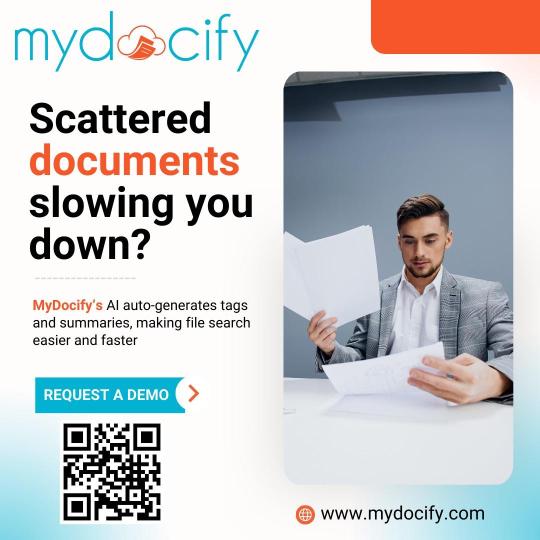
Mydocify - Streamlined Document Management Software for Businesses
Mydocify is a powerful document management software that helps businesses efficiently organize, store, and retrieve files. Experience seamless document collaboration, version control, and enhanced security with Mydocify’s cloud-based solution.
#document management software#salesforce document management#Document Workflow#Secure and Efficient File Organization#marketing#branding
0 notes
Text
Overcoming Pain Points with Document management Solutions
Cloud Document Management: Difficulty in managing documents stored in the cloud, leading to security and access concerns Workflow Automation: Lack of automation results in time-consuming and error-prone document workflows Document Lifecycle Management: Challenges in managing documents throughout their lifecycle, from creation to disposal Workflow Tracking: Inability to track the status of documents throughout the workflow process Access and Version Control: Difficulty in controlling access to documents and tracking document versions accurately Centralized File Management: Document management software provides a centralized repository for storing and accessing files, improving organization and accessibility.
About the Sunsmart: SunSmart tackles cloud storage complexities, automates workflows, simplifies document lifecycle management, enables real-time tracking, and ensures precise access control. With centralized file management, SunSmart enhances organization and accessibility, providing a seamless solution to document management hurdles.
Contact us : website - https://www.sunsmart.co.in/product/document-management-software-india-chennai-mumbai-bangalore-delhi.html | https://www.sunsmartglobal.com/document-management-software-dubai-qatar-uae-usa-london/ Whatsup - https://wa.link/g2d5fw mail - [email protected]
Follow us: Twitter - https://twitter.com/home Instagram - https://www.instagram.com/sunsmartglobal/ Linkedin - https://www.linkedin.com/in/sunsmart-global-1b68a6143/ Facebook - https://www.facebook.com/
0 notes
Text
DMS Blog 1 Top 5 Key Features Using Document Management Software for an HR Department
SEO Meta-Description: Explore the top 5 key features that a document management software offers for enhancing HR department efficiency, including secure access control, document version control, integration with HR systems, compliance, and more.
Introduction
Managing documents efficiently is crucial for HR departments to streamline operations and enhance productivity. Document management software plays a pivotal role in achieving these goals by offering a range of key features tailored for HR needs.
What is Document Management Software?
Document Management Software (DMS) is a digital solution designed to organize, store, and track documents and information digitally. It eliminates the need for paper-based document handling and provides a centralized platform for managing HR-related documents.
Importance in HR Departments
For HR departments, DMS is indispensable as it simplifies document handling, reduces errors, ensures compliance with regulations, and enhances data security and confidentiality.
Benefits for HR Operations
Implementing DMS in HR operations brings numerous benefits, including improved efficiency, faster document retrieval, better collaboration among team members, reduced costs associated with manual paperwork, and enhanced data accuracy.
Challenges in HR Document Management
Despite its benefits, HR document management comes with challenges such as data security concerns, compliance requirements, document version control issues, and ensuring seamless integration with existing HR systems.
Key Feature 1: Secure Access Control
User Permissions: DMS allows HR admins to assign specific access permissions to users based on their roles and responsibilities, ensuring data confidentiality and preventing unauthorized access.
Role-Based Access: With role-based access control, HR staff can access only the information relevant to their roles, maintaining data integrity and confidentiality within the organization.
Audit Trails: DMS generates audit trails that track document access, modifications, and activities, providing transparency and accountability in document management processes.
Key Feature 2: Document Version Control
Version History: DMS maintains a detailed version history of documents, allowing HR teams to track changes, revert to previous versions if needed, and ensure document accuracy and compliance.
Revision Tracking: The software tracks revisions made to documents, including who made the changes and when, facilitating collaboration while maintaining version control.
Key Feature 3: Document Search and Retrieval
Full-Text Search: DMS enables HR professionals to perform full-text searches across documents, making it easy to locate specific information quickly and efficiently.
Metadata Tagging: By tagging documents with metadata such as keywords, categories, and tags, DMS enhances searchability and categorization, improving document retrieval processes.
Key Feature 4: Integration with HR Systems
Seamless Data Exchange: DMS seamlessly integrates with existing HR systems, allowing for automated data exchange, synchronization of employee records, and streamlined workflows.
Automated Workflows: Integration with HR systems enables automated workflows for tasks such as employee onboarding, performance reviews, and compliance checks, improving HR efficiency.
Key Feature 5: Compliance and Security
Data Encryption: DMS employs robust encryption techniques to protect sensitive HR data, ensuring compliance with data protection regulations and safeguarding against data breaches.
Compliance Checks: The software conducts compliance checks to ensure HR documents adhere to regulatory requirements, helping organizations avoid legal risks and penalties.
Disaster Recovery: DMS includes disaster recovery features such as data backup, recovery options, and continuity planning, minimizing data loss and downtime during unforeseen events.
FAQs
How does Document Management Software improve HR efficiency?
Document Management Software automates document handling, enhances collaboration, ensures data security, and streamlines workflows, leading to improved HR efficiency.
What are the key security features of Document Management Software?
Document Management Software offers features like data encryption, access control, audit trails, compliance checks, and disaster recovery to ensure robust security for HR documents.
Can Document Management Software integrate with other HR systems?
Yes, Document Management Software can seamlessly integrate with existing HR systems, enabling automated data exchange, workflow synchronization, and enhanced operational efficiency.
How does Document Version Control benefit HR departments?
Document Version Control enables HR departments to track document changes, maintain version history, ensure compliance, and collaborate effectively while maintaining data accuracy.
What compliance regulations does Document Management Software adhere to?
Document Management Software adheres to various compliance regulations such as GDPR, HIPAA, SOX, and industry-specific standards, ensuring data protection and regulatory compliance.
How does Document Management Software enhance document search and retrieval?
Document Management Software offers full-text search capabilities, metadata tagging, advanced search filters, and categorization features, making document search and retrieval efficient and accurate.
Conclusion
In conclusion, Document Management Software provides HR departments with essential tools to streamline document management, enhance collaboration, ensure data security and compliance, and improve overall operational efficiency. By leveraging the top 5 key features discussed, HR professionals can optimize their workflows, mitigate risks, and focus on strategic HR initiatives.
<a href="https://www.nte.ai/Blog/business/dms-blog-1-top-5-key-features-using-document-management-software-for-an-hr-department/ ?utm_source=backlink&utm_medium=directory+submission&utm_campaign=organic">Visit nte.ai</a>
0 notes
Text
Creating a personal fanfic archive using Calibre, various Calibre plugins, Firefox Reader View, and an e-Reader / BookFusion / Calibre-Web
A few years ago I started getting serious about saving my favorite fic (or just any fic I enjoyed), since the Internet is sadly not actually always forever when it comes to fanfiction. Plus, I wanted a way to access fanfic offline when wifi wasn't available. Enter a personal fanfic archive!
There are lots of ways you can do this, but I thought I'd share my particular workflow in case it helps others get started. Often it's easier to build off someone else's workflow than to create your own!
Please note that this is for building an archive for private use -- always remember that it's bad form to publicly archive someone else's work without their explicit permission.
This is going to be long, so let's add a read more!
How to Build Your Own Personal Fanfic Archive
Step One: Install Calibre
Calibre is an incredibly powerful ebook management software that allows you to do a whole lot of stuff having to do with ebooks, such as convert almost any text-based file into an ebook and (often) vice-versa. It also allows you to easily side-load ebooks onto your personal e-reader of choice and manage the collection of ebooks on the device.
And because it's open source, developers have created a bunch of incredibly useful plugins to use with Calibre (including several we're going to talk about in the next step), which make saving and reading fanfiction super easy and fun.
But before we can do that, you need to download and install it. It's available for Windows, MacOS, Linux, and in a portable version.
Step Two: Download These Plugins
This guide would be about 100 pages long if I went into all of the plugins I love and use with Calibre, so we're just going to focus on the ones I use for saving and reading fanfiction. And since I'm trying to keep this from becoming a novel (lolsob), I'll just link to the documentation for most of these plugins, but if you run into trouble using them, just tag me in the notes or a comment and I'll be happy to write up some steps for using them.
Anyway, now that you've downloaded and installed Calibre, it's time to get some plugins! To do that, go to Preferences > Get plugins to enhance Calibre.
You'll see a pop-up with a table of a huge number of plugins. You can use the Filter by name: field in the upper right to search for the plugins below, one at a time.
Click on each plugin, then click Install. You'll be asked which toolbars to add the plugins to; for these, I keep the suggested locations (in the main toolbar & when a device is connected).
FanFicFare (here's also a great tutorial for using this plugin) EpubMerge (for creating anthologies from fic series) EbubSplit (for if you ever need to break up fic anthologies) Generate Cover (for creating simple artwork for downloaded fic) Manage Series (for managing fic series)
You'll have to restart Calibre for the plugins to run, so I usually wait to restart until I've installed the last plugin I want.
Take some time here to configure these plugins, especially FanFicFare. In the next step, I'll demonstrate a few of its features, but you might be confused if you haven't set it up yet! (Again, highly recommend that linked tutorial!)
Step Three: Get to Know FanFicFare (and to a lesser extent, Generate Cover)
FanFicFare is a free Calibre plugin that allows you to download fic in bulk, including all stories in a series as one work, adding them directly to Calibre so that that you can convert them to other formats or transfer them to your e-reader.
As with Calibre, FanFicFare has a lot of really cool features, but we're just going to focus on a few, since the docs above will show you most of them.
The features I use most often are: Download from URLs, Get Story URLs from Email, and Get Story URLs from Web Page.
Download from URLs let's you add a running list of URLs that you'd like FanFicFare to download and turn into ebooks for you. So, say, you have a bunch of fic from fanfic.net that you want to download. You can do that!
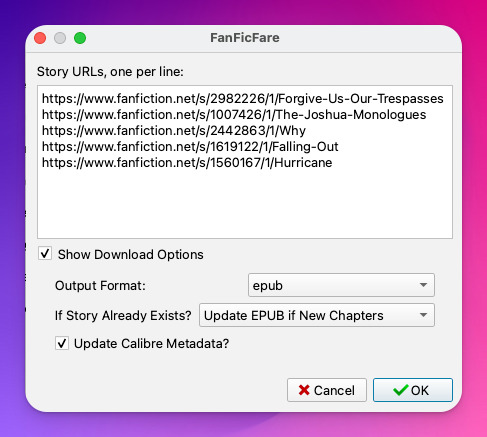
Now, in this case, I've already downloaded these (which FanFicFare detected), so I didn't update my library with the fic.
But I do have some updates to do from email, so let's try getting story URLs from email!
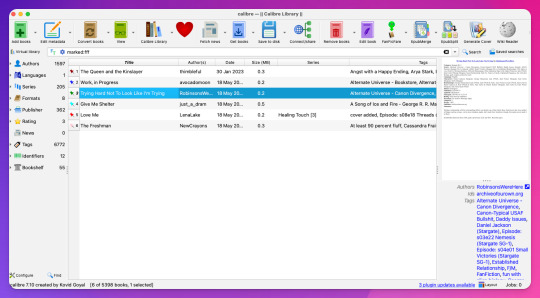
Woohoo, new fic! Calibre will detect when cover art is included in the downloaded file and use that, but at least one of these fic doesn't have cover art (which is the case for most of the fic I download). This is where Generate Cover comes in.
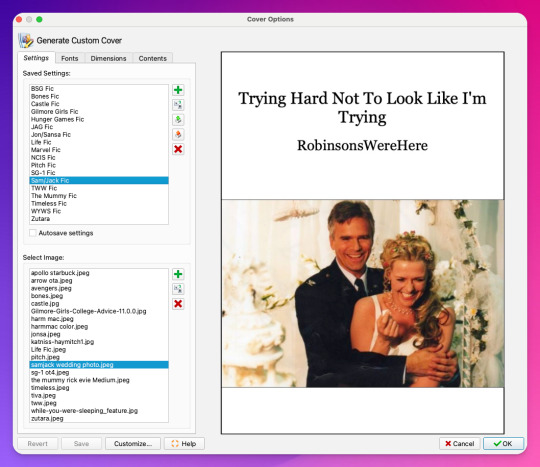
With Generate Cover, I can set the art, font, dimensions, and info content of the covers so that when I'm looking at the fic on my Kindle, I know right away what fic it is, what fandom it's from, and whether or not it's part of a series.
Okay, last thing from FanFicFare -- say I want to download all of the fic on a page, like in an author's profile on fanfic.net or all of the stories in a series. I can do that too with Get Story URLs from Web Page:
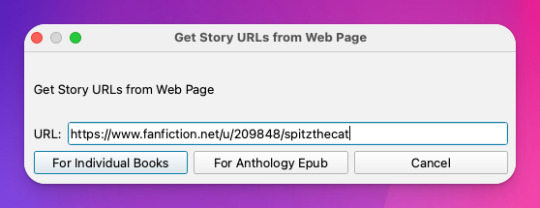
The thing I want to call out here is that I can specify whether the fic at this link are individual works or all part of an anthology, meaning if they're all works in the same series, I can download all stories as a single ebook by choosing For Anthology Epub.
Step Four: Using FireFox Reader View to Download Fic Outside of Archives
This is less common now thanks to AO3, but the elders among us may want to save fanfic that exists outside of archives on personal websites that either still exist or that exist only on the Internet Wayback Machine. FanFicFare is awesome and powerful, but it's not able to download fic from these kinds of sources, so we have to get creative.
I've done this in a couple of ways, none of which are entirely perfect, but the easiest way I've found thus far is by using Firefox's Reader View. Also, I don't think I discovered this -- I think I read about this on Tumblr, actually, although I can longer find the source (if you know it, please tell me so I can credit them!).
At any rate, open the fic in Firefox and then toggle on Reader View:

Toggling on Reader View strips all the HTML formatting from the page and presents the fic in the clean way you see in the preview below, which is more ideal for ebook formats.
To save this, go to the hamburger menu in the upper right of the browser and select Print, then switch to Print to PDF. You'll see the URL and some other stuff at the top and bottom of the pages; to remove that, scroll down until you see something like More settings... and uncheck Print headers and footers.
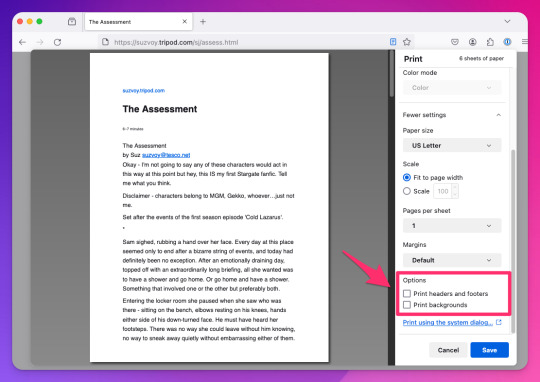
Click Save to download the resulting PDF, which you can then add to Calibre and convert to whichever format works best for your e-reader or archive method.
Step Five: Archiving (Choose Your Own Adventure)
Here's the really fun part: now that you know how to download your fave fanfics in bulk and hopefully have a nice little cache going, it's time to choose how you want to (privately) archive them!
I'm going to go through each option I've used in order of how easy it is to implement (and whether it costs additional money to use). I won't go too in depth about any of them, but I'm happy to do so in a separate post if anyone is interested.
Option 1: On Your Computer
If you're using Calibre to convert fanfic, then you're basically using your computer as your primary archive. This is a great option, because it carries no additional costs outside the original cost of acquiring your computer. It's also the simplest option, as it really doesn't require any advanced technical knowledge, just a willingness to tinker with Calibre and its plugins or to read how-to docs.
Calibre comes with a built-in e-book viewer that you can use to read the saved fic on your computer (just double-click on the fic in Calibre). You can also import it into your ebook app of choice (in most cases; this can get a little complicated just depending on how many fic you're working with and what OS you're on/app you're using).
If you choose this option, you may want to consider backing the fic up to a secondary location like an external hard drive or cloud storage. This may incur additional expense, but is likely still one of the more affordable options, since storage space is cheap and only getting cheaper, and text files tend to not be that big to begin with, even when there are a lot of them.
Option 2: On Your e-Reader
This is another great option, since this is what Calibre was built for! There are some really great, afforable e-readers out there nowadays, and Calibre supports most of them. Of course, this is a more expensive option because you have to acquire an e-reader in addition to a computer to run Calibre on, but if you already have an e-reader and haven't considered using it to read fanfic, boy are you in for a treat!
Option 3: In BookFusion
This is a really cool option that I discovered while tinkering with Calibre and used for about a year before I moved to a self-hosted option (see Option 4).
BookFusion is a web platform and an app (available on iOS and Android) that allows you to build your own ebook library and access it from anywhere, even when you're offline (it's the offline bit that really sold me). It has a Calibre plugin through which you can manage your ebook library very easily, including sorting your fanfic into easy-to-access bookshelves. You may or may not be able to share ebooks depending on your subscription, but only with family members.
Here's what the iOS app looks like:
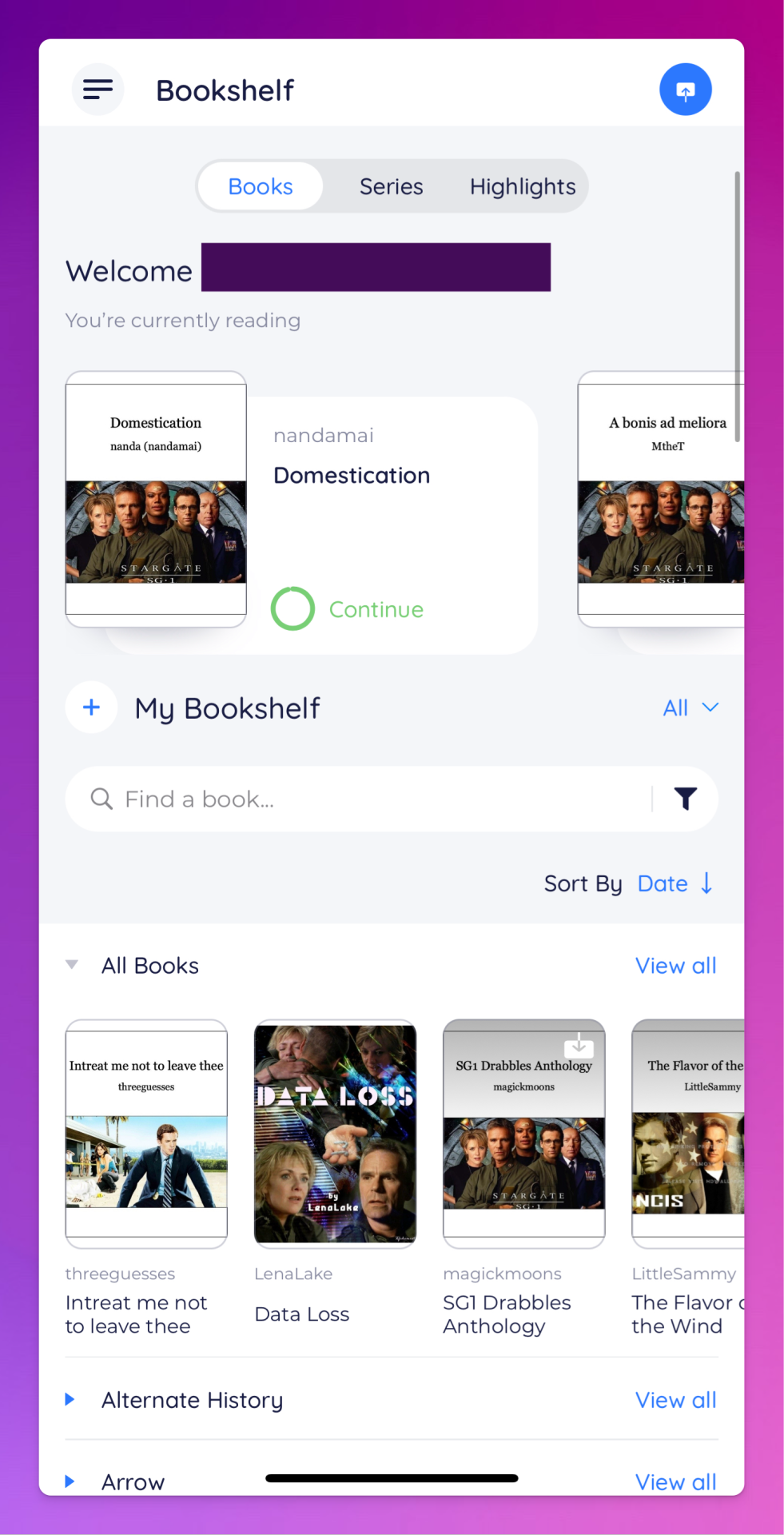
The downside to BookFusion is that you'll need a subscription if you want to upload more than 10 ebooks. It's affordable(ish), ranging from $1.99 per month for a decent 5GB storage all the way to $9.99 for 100GB for power users. Yearly subs range from $18.99 to $95.99. (They say this is temporary, early bird pricing, but subscribing now locks you into this pricing forever.)
I would recommend this option if you have some cash to spare and you're really comfortable using Calibre or you're a nerd for making apps like BookFusion work. It works really well and is incredibly convenient once you get it set up (especially when you want to read on your phone or tablet offline), but even I, someone who works in tech support for a living, had some trouble with the initial sync and ended up duplicating every ebook in my BookFusion library, making for a very tedious cleanup session.
Option 4: On a Self-Hosted Server Using Calibre-Web
Do you enjoy unending confusion and frustration? Are you okay with throwing fistfuls of money down a well? Do you like putting in an incredible amount of work for something only you and maybe a few other people will ever actually use? If so, self-hosting Calibre-Web on your own personal server might be a good fit for you!
To be fair, this is likely an experience unique to me, because I am just technical enough to be a danger to myself. I can give a brief summary of how I did this, but I don't know nearly enough to explain to you how to do it.
Calibre-Web is a web app that works on top of Calibre, offering "a clean and intuitive interface for browsing, reading, and downloading eBooks."
I have a network-attached storage (NAS) server on which I run an instance of Calibre and Calibre-Web (through the miracle that is Docker). After the initial work of downloading all the fic I wanted to save and transferring it to the server, I'm now able to download all new fic pretty much via email thanks to FanFicFare, so updating my fic archive is mostly automated at this point.
If you're curious, this is what it looks like:

Pros: The interface is clean and intuitive, the ebook reader is fantastic. The Discover feature, in which you are given random books / fic to read, has turned out to be one feature worth all the irritation of setting up Calibre-Web. I can access, read, and download ebooks on any device, and I can even convert ebooks into another format using this interface. As I mentioned above, updating it with fic (and keeping the Docker container itself up to date) is relatively automated and easy now.
Cons: The server, in whichever form you choose, costs money. It is not cheap. If you're not extremely careful (and sometimes even if you are, like me) and a hard drive goes bad, you could lose data (and then you have to spend more money to replace said hard drive and time replacing said data). It is not easy to set up. You may, at various points in this journey, wish you could launch the server into the sun, Calibre-Web into the sun, or yourself into the sun.
Step Six: Profit!
That's it! I hope this was enough to get you moving towards archiving your favorite fanfic. Again, if there's anything here you'd like me to expand on, let me know! Obviously I'm a huge nerd about this stuff, and love talking about it.
#genie's stuff#calibre#calibre-web#bookfusion#personal fanfic archive#archiving fanfic#saving fanfic
103 notes
·
View notes
Text
Elon Musk’s so-called Department of Government Efficiency (DOGE) operates on a core underlying assumption: The United States should be run like a startup. So far, that has mostly meant chaotic firings and an eagerness to steamroll regulations. But no pitch deck in 2025 is complete without an overdose of artificial intelligence, and DOGE is no different.
AI itself doesn’t reflexively deserve pitchforks. It has genuine uses and can create genuine efficiencies. It is not inherently untoward to introduce AI into a workflow, especially if you’re aware of and able to manage around its limitations. It’s not clear, though, that DOGE has embraced any of that nuance. If you have a hammer, everything looks like a nail; if you have the most access to the most sensitive data in the country, everything looks like an input.
Wherever DOGE has gone, AI has been in tow. Given the opacity of the organization, a lot remains unknown about how exactly it’s being used and where. But two revelations this week show just how extensive—and potentially misguided—DOGE’s AI aspirations are.
At the Department of Housing and Urban Development, a college undergrad has been tasked with using AI to find where HUD regulations may go beyond the strictest interpretation of underlying laws. (Agencies have traditionally had broad interpretive authority when legislation is vague, although the Supreme Court recently shifted that power to the judicial branch.) This is a task that actually makes some sense for AI, which can synthesize information from large documents far faster than a human could. There’s some risk of hallucination—more specifically, of the model spitting out citations that do not in fact exist—but a human needs to approve these recommendations regardless. This is, on one level, what generative AI is actually pretty good at right now: doing tedious work in a systematic way.
There’s something pernicious, though, in asking an AI model to help dismantle the administrative state. (Beyond the fact of it; your mileage will vary there depending on whether you think low-income housing is a societal good or you’re more of a Not in Any Backyard type.) AI doesn’t actually “know” anything about regulations or whether or not they comport with the strictest possible reading of statutes, something that even highly experienced lawyers will disagree on. It needs to be fed a prompt detailing what to look for, which means you can not only work the refs but write the rulebook for them. It is also exceptionally eager to please, to the point that it will confidently make stuff up rather than decline to respond.
If nothing else, it’s the shortest path to a maximalist gutting of a major agency’s authority, with the chance of scattered bullshit thrown in for good measure.
At least it’s an understandable use case. The same can’t be said for another AI effort associated with DOGE. As WIRED reported Friday, an early DOGE recruiter is once again looking for engineers, this time to “design benchmarks and deploy AI agents across live workflows in federal agencies.” His aim is to eliminate tens of thousands of government positions, replacing them with agentic AI and “freeing up” workers for ostensibly “higher impact” duties.
Here the issue is more clear-cut, even if you think the government should by and large be operated by robots. AI agents are still in the early stages; they’re not nearly cut out for this. They may not ever be. It’s like asking a toddler to operate heavy machinery.
DOGE didn’t introduce AI to the US government. In some cases, it has accelerated or revived AI programs that predate it. The General Services Administration had already been working on an internal chatbot for months; DOGE just put the deployment timeline on ludicrous speed. The Defense Department designed software to help automate reductions-in-force decades ago; DOGE engineers have updated AutoRIF for their own ends. (The Social Security Administration has recently introduced a pre-DOGE chatbot as well, which is worth a mention here if only to refer you to the regrettable training video.)
Even those preexisting projects, though, speak to the concerns around DOGE’s use of AI. The problem isn’t artificial intelligence in and of itself. It’s the full-throttle deployment in contexts where mistakes can have devastating consequences. It’s the lack of clarity around what data is being fed where and with what safeguards.
AI is neither a bogeyman nor a panacea. It’s good at some things and bad at others. But DOGE is using it as an imperfect means to destructive ends. It’s prompting its way toward a hollowed-out US government, essential functions of which will almost inevitably have to be assumed by—surprise!—connected Silicon Valley contractors.
12 notes
·
View notes
Text
Why Document Workflow Automation Is Quietly Transforming Businesses
Not too long ago, most offices were still buried under paperwork. Files would sit in cabinets, approvals took days, and one missing document could slow everything down. Even today, many businesses are stuck in that loop—but they don’t need to be. That’s where document workflow automation steps in.
Think of it as a better way to get things done. Instead of chasing signatures or wondering who has the latest version of a file, automation takes care of it for you. It’s not flashy. It just works—and that’s the beauty of it.

What Exactly Is Document Workflow Automation?
It’s simple: automate how your documents move within your organization.
Say you’ve got a purchase order. Instead of emailing it to your manager, waiting for them to sign, then forwarding it to accounts, automation sends it where it needs to go—all by itself. It can even send reminders if someone forgets to approve.
The goal isn’t to replace people. It’s to give them fewer things to chase. That means fewer mistakes, less back-and-forth, and more time spent on actual work.
Do You Really Need a Workflow Automation Solution?
Let’s be honest—most businesses run on habits. If you’ve been handling files a certain way for years, changing things might feel unnecessary. But look closely. How often do approvals get delayed? How many hours are lost searching for documents? How many small errors slip through the cracks?
A solid workflow automation solution fixes these problems quietly. It’s not a big dramatic change. It’s more like fixing the squeaky hinge on a door—suddenly, things just move smoother.
What Makes a Good Document Management System?
There are a lot of tools out there promising to be the best document management system. But “best” depends on what your business needs.
Look for software that’s easy to use—something your team won’t need two weeks of training to understand. It should let you upload and find files fast, assign permissions, and track document versions without confusion. Cloud storage is a plus, especially if your team works from different locations.
And don’t underestimate clean design. If your employees hate the interface, they won’t use it—no matter how powerful it is.
Enterprise Workflow Management Software Isn’t Just for Corporates
Sure, big companies benefit the most from enterprise-level tools. But even midsize firms can gain a lot from enterprise workflow management software. Why?
Because the more moving parts your business has—teams, locations, clients—the harder it is to stay organized. Automating workflows across departments brings order to the chaos. Plus, you’ll finally have visibility into what’s happening where, and why.
The Human Side of Automation
People sometimes worry that automation will make everything cold or impersonal. But if you implement it right, it does the opposite.
With fewer repetitive tasks to worry about, teams can actually talk more, not less. Collaboration improves when the boring stuff is taken care of. Automation isn’t about removing people—it’s about helping them work better together.
Final Thoughts: Less Stress, More Control
No one ever says, “I wish we had more manual processes.” That’s because chasing files and approvals is exhausting. You shouldn’t have to double-check whether something was sent, signed, or stored.
Whether you’re a small team or a large company, using the right document automation solutions and workflow automation tools makes life easier. You’ll spend less time fixing problems—and more time growing your business.
And at the end of the day, that’s what it’s really about.
#document workflow automation#workflow automation solution#best document management software#best document management system#document automation solutions#enterprise workflow management software
0 notes
Text
Weirdly Motivated to Write



Well, I did say that I have a new keyboard—to correct my posture and not look like a pretzel while I work remotely. Small victories, right?
Now, let’s talk about motivation. Because for some reason, I am absolutely buzzing with it today. Is it because of my keyboard? Most likely. Is that weird? Probably. But hey, I never claimed to be normal.
See, besides being a full-time student, I also have a job. And that job? Writing. Creating. Capturing life in words, pictures, and fleeting moments of inspiration. Filming, writing, photography—these are the things that make me absolutely happy. And honestly? Life is just too beautiful not to share.
There’s something about having the right tools that makes everything feel different. You could give me the exact same blank document yesterday, and I wouldn’t have been nearly as eager to write as I am today. But now? With my new keyboard? I feel like I could churn out a whole novel, rewrite history, or at the very least, write an unnecessarily long blog post about why I feel like writing.
Maybe it’s the clickity-clackity. (Yes, that’s a technical term.) There’s just something deeply satisfying about hearing each keystroke, like a tiny round of applause with every word I type. It’s hypnotizing. Encouraging. Addictive, even. Without it, I don’t think I’d be half as motivated to write.
And that brings me to a very important question:
Could this mean my iPad will replace my laptop?
Ha! Not a chance. Never. Not in a million years.
As much as I love this setup, there are things my iPad just cannot do. And honestly, those things make a huge difference in my daily workflow. Don’t get me wrong—iPads are fantastic. They’re lightweight, portable, and perfect for quick notes, reading, or sketching. But when it comes to serious work? My Windows laptop remains irreplaceable.



Why My Windows Laptop Wins Every Time
Multitasking Like a Pro iPads have some multitasking capabilities, but let's be real—nothing beats having multiple windows open, side by side, without limitations. On my laptop, I can have a research paper in one window, my notes in another, a video playing on the side, and Spotify running in the background. Try doing that on an iPad without constantly swiping between apps. It’s just not the same.
File Management That Actually Makes Sense The Windows file system is superior. Hands down. Drag-and-drop functionality, proper file explorer, external drive support—it’s just easier. iPads, on the other hand, have a clunky file system that often makes me want to scream into the void. Copying files? Moving them? Finding them again? It takes way longer than it should.
Software Compatibility & Heavy-Duty Programs This one’s a dealbreaker. There are so many professional-grade applications that just don’t run on iPads. Things like:
Adobe Premiere Pro for serious video editing (iPad versions are limited)
Photoshop & Illustrator (yes, they have mobile versions, but they’re nowhere near as powerful)
Microsoft Excel with Macros (because let's be honest, the iPad version is lacking)
Programming software & full IDEs (if I ever decide to code, my iPad will just sit there, useless)
Mouse & Keyboard Freedom Yes, iPads can connect to a mouse and keyboard, but do they truly function like a laptop? Nope. There are still weird limitations. Right-clicking? Custom shortcuts? The precision of a real trackpad or external mouse? Windows just does it better. Period.
Downloading Anything Without Jumping Through Hoops iPads don’t let you download everything you want, especially if it’s outside the App Store. Need a program that isn’t on Apple’s list of approved software? Too bad. Meanwhile, on Windows? I can download whatever I want, whenever I want, however I want. No restrictions.
Serious Writing & Formatting Writing on an iPad is fine for quick drafts, but when it comes to formatting long documents, citations, and exporting files in different formats? My laptop is my best friend. Whether it's proper PDF editing, running reference managers like Zotero, or managing multiple Word documents with complex layouts, iPads just don’t cut it.
Gaming & Emulation Okay, maybe not work-related, but still important! iPads have mobile games, sure. But do they run full-fledged PC games? Nope. Can I use them for game modding? Nope. Can I play older games with emulators? Again, nope. My Windows laptop, on the other hand? Unlimited possibilities.
The Verdict?
As much as I love the convenience of my iPad + keyboard combo, it will never replace my laptop. Ever. My laptop is where the real magic happens—the deep work, the serious projects, the things that actually require a proper computer.
But will I still use my iPad for writing on the go? Absolutely. Because nothing beats the clickity-clackity joy of my new keyboard. And if that keeps me weirdly motivated to write, then hey—I’ll take it.
So if you ever see me typing away somewhere, looking ridiculously focused, just know—it’s not me. It’s the keyboard.
#book#books#bookstore#new books#book review#booklr#books and reading#bookworm#book quotes#book blog#old books#bookblr#books & libraries#read#reading#reader#currently reading#long reads#library#literature#classic literature#english literature#book lover#english#classic#classics#bookshelf#bookshelves#productivity#ipad
10 notes
·
View notes
Text

As Per My Last Void Whisper
A friend just blew my mind. Write what you know took on a whole new meaning this week:
Friend: Elu manages corruption like a career
Me: it is her “career”?
Friend: yeah but who makes the void file tps reports 😏
And that's when the lightbulb went off. The Void as a metaphor for the artistic process—messy, unpredictable, yet full of potential when structured correctly. Making the abstract actionable.
Her approach, the ability to quantify and catalog the unquantifiable comes from something I know all too well: the challenge of making art/design/ux/ui understandable to software engineers.
Making something flowery and feel-y like say, why I chose to make something in the ui blue, becomes less “i just think it's pretty” and more “let's reference the established psychological framework for color along with the brand guidelines”. Because they will argue logic for all of your design decisions. But! You're the expert here, and you have logical answers. (So fun.)
Writing technical documentation, workflows, analyzing data, and presenting that work to entirely different disciplines seems so boring when you compare it to fiction/fantasy/rp. But I absolutely love it. With Elu being an academic, or at the very least a nerd, she brings that same spirit of rigor to her own world. And how she manages darkness becomes a theme that isn't so surprising after all.
Not to mention, satire and absurd humor are the best. All workplaces are ridiculous, but that was the easy part to lean into. The Void is chaos, but there's a method for dealing with the madness.
Write what you know, indeed.
11 notes
·
View notes
Text
The Shift to Cloud-Based Auditing – Why Firms Are Moving Towards Digital Audit Solutions
The auditing landscape is undergoing a massive transformation with the rapid adoption of cloud-based audit software. As regulatory requirements grow stricter and businesses seek efficiency, firms are shifting towards audit workflow management software to streamline processes, enhance security, and ensure compliance. This digital shift is not just a trend—it’s a necessity for firms aiming to stay competitive in a rapidly evolving financial environment.
The Need for Digital Audit Solutions
Traditional auditing methods relied heavily on manual data entry, paper-based documentation, and inefficient workflow management. These outdated processes often led to errors, compliance risks, and delays in report generation. The rise of audit automation software has eliminated these challenges by providing real-time collaboration, automated reporting, and AI-powered insights for auditors and accountants.
Key drivers for the adoption of cloud-based audit software include:
Increasing regulatory scrutiny and compliance complexities
The need for secure, remote access to audit files
Demand for enhanced accuracy and reduced manual errors
Efficient management of large volumes of financial data
Cost-effectiveness and scalability of cloud solutions
Benefits of Cloud-Based Audit Solutions
Enhanced Workflow Automation
A cloud-based audit workflow management system helps firms automate repetitive tasks, improving efficiency and productivity. Features like audit file management software and audit sampling software enable auditors to manage documentation, track workflows, and generate reports with minimal effort.
Improved Data Security and Compliance
Cloud-based audit management software solutions come with robust security measures, including encryption, multi-factor authentication, and compliance with international data protection standards. Unlike traditional on-premise audit tools, cloud solutions offer automated updates to meet regulatory changes in statutory audits. https://audtech.co.in/2025/04/08/the-shift-to-cloud-based-auditing-why-firms-are-moving-towards-digital-audit-solutions/
Seamless Collaboration and Remote Access
With firms adopting hybrid and remote work models, audit workflow software enables real-time collaboration. Team members can access audit files securely from anywhere, reducing dependency on physical office spaces. This feature is especially beneficial for statutory audit firms that handle global clients.
Cost-efficiency and Scalability
Cloud-based audit digitization software reduces infrastructure costs, eliminating the need for physical servers and extensive IT maintenance. Firms can scale their audit management software as needed, ensuring flexibility in handling audits of varying complexities.
Advanced Analytics and AI-Powered Insights
Modern audit software for accountants and CPA firms integrates data analytics tools to detect anomalies, assess risks, and provide predictive insights. This enhances decision-making and strengthens the overall audit process by identifying potential fraud or compliance breaches early.
Key Compliance Challenges Addressed by Cloud Auditing
One of the primary reasons firms are shifting towards cloud-based audit automation software is to ensure compliance with ever-changing regulatory requirements. The latest audit quality maturity models emphasize the importance of audit sampling tools, digital record-keeping, and automated compliance checks. Top statutory audit software solutions now include built-in regulatory updates, reducing the burden on firms to track compliance changes manually.
Implementing Cloud-Based Auditing – Best Practices
To fully leverage the benefits of audit workflow management, firms should follow these best practices:
Choose the Right Audit Management Software – Select a solution with audit file management, document collaboration, and compliance tracking.
Train Your Team – Ensure auditors and accountants are well-trained in using audit automation software to maximize efficiency.
Prioritize Data Security – Implement strict security protocols, including multi-layer encryption and access control features.
Monitor Regulatory Updates – Use software with built-in compliance tracking to stay aligned with statutory audit regulations.
Conclusion
The shift to cloud-based audit solutions is no longer optional—it’s an industry standard for firms aiming to improve efficiency, compliance, and security. Investing in audit workflow software enables firms to stay ahead in an increasingly complex regulatory environment while optimizing operations. By adopting audit automation software, firms can reduce errors, enhance collaboration, and ensure compliance with evolving audit regulations.
Whether you’re a small CPA firm or a large accounting practice, upgrading to cloud-based audit tools will future-proof your business and position it for long-term success.
Optimize your audit process today with a powerful cloud-based solution. Explore the best-in-class audit software tailored for statutory audits, financial reporting, and compliance management.
Contact
Office No. 810, 8th Floor,
LMS Finswell, Viman Nagar, Pune, Maharashtra, India, 411014
+91 9112118221 / [email protected]

0 notes
Text
Unlocking Efficiency with the Ultimate Document Management Software: PDQ Docs
Document management is considered highly important in today’s fast-paced business world. From tracking important files to collaborating with teams, managing documents can quickly become overwhelming without the right tools. That’s where the ultimate document management software, PDQ Docs, steps in. With its robust features and user-friendly interface, PDQ Docs is designed to simplify document storage, retrieval, and collaboration, making it an essential tool for any organization looking to improve productivity and organization.
Seamless Collaboration and Sharing
Collaboration is at the heart of most business operations, and PDQ Docs makes working together on documents effortless. With built-in sharing capabilities, you can grant access to team members, clients, or partners with just a few clicks. The ultimate document management software allows for real-time collaboration, so multiple users can work on the same document simultaneously, without the fear of overwriting each other’s changes. In addition, PDQ Docs offers version control, meaning all edits are tracked, and you can easily revert to previous versions if necessary. This feature ensures that everyone is on the same page, streamlining workflow and reducing the risk of errors.

Enhanced Security and Compliance
When it comes to managing sensitive information, security is a top concern for any business. PDQ Docs understands this need and offers advanced security features to protect your documents. With encrypted storage and secure access controls, you can ensure that only authorized individuals can view or edit certain files. The ultimate document management software also supports multi-factor authentication, adding an extra layer of protection. For businesses that need to comply with industry regulations, PDQ Docs is built with compliance in mind. The software adheres to best practices for data protection and privacy, helping businesses meet the requirements of standards like HIPAA, GDPR, and more.
Efficient Document Search and Retrieval
Searching for a document in a traditional file system can be time-consuming and frustrating. However, PDQ Docs simplifies this process with powerful search functionality. Its robust search engine allows users to search by keywords, tags, or metadata, making it easy to locate any document within seconds. Whether you need to find a specific contract or retrieve an old invoice, PDQ Docs ensures that every file is just a few clicks away. This feature not only saves time but also enhances productivity by minimizing the effort required to manage documents.
Conclusion
In today’s digital landscape, efficient document management is a key factor in maintaining productivity and organization. PDQ Docs stands out as the ultimate document management software, offering streamlined organization, seamless collaboration, enhanced security, and powerful search capabilities. With its scalability and user-friendly interface, PDQ Docs is the ideal solution for businesses looking to take control of their documents and improve overall efficiency. By choosing PDQ Docs, organizations can ensure that their document management processes are as effective and secure as possible, allowing them to focus on what truly matters: growing their business.
#ultimate document management software#document management system#file organization software#central based document storage#enterprise document management#document collaboration tools#version control for documents#secure file sharing software#paperless office solution#document workflow automation#business document management#document archiving system
0 notes